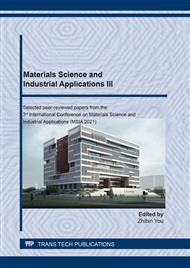p.3
p.9
p.15
p.23
p.29
p.35
p.45
p.51
Numerical Mechanical Analysis of Filled Rubber under Different Deformation States Based on a New Hyperelastic Constitutive Model
Abstract:
The accuracy of the rubber constitutive model characterizing experiment data has a crucial influence on the mechanical analysis of rubber structures. In this paper, a new improved hyperelastic constitutive model is proposed, and the model is derived into the stress-strain forms of uniaxial tension, equibiaxial tension and pure shear. Based on the experimental data of filled rubber, the material parameters of each deformation state are obtained by using the newly proposed rubber hyperelastic constitutive model, and the uniaxial tensile (UT), Equibiaxial tension (ET) and Pure shear (PS) specimens are simulated and calculated in the finite element software. the stress state of each finite element specimen is analyzed and the obtained simulation data are compared with the experimental data. It is found that the new model can accurately characterize the hyperelastic mechanical properties of the experimental specimens in different deformation states. At the same time, the reasons for the deviation from the experimental data in the process of plane tensile simulation are analyzed and explained comprehensively. The reliability and accuracy of the classical rubber constitutive relations of polynomial models and eight-chain model are studied. the results show that different hyperelastic models have different ability to describe the hyperelastic behavior in different deformation states. the hyperelastic constitutive model proposed in this paper can be easily embedded into finite element software and has the advantages of accurate results, few material parameters and simple testing.
Info:
Periodical:
Pages:
15-22
Citation:
Online since:
May 2021
Authors:
Price:
Сopyright:
© 2021 Trans Tech Publications Ltd. All Rights Reserved
Share:
Citation:


